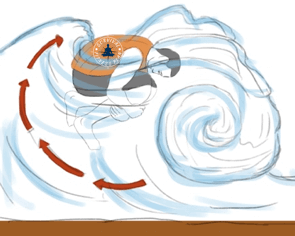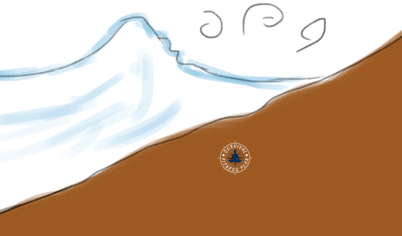Swimming in Waves – Wave Identification and Swimming Techniques
Learn how to swim in the ocean waves and how to identify different types of waves. Knowing how to identify and use them to your advantage makes swimming in waves much safer. You will also discover why waves break.
GET YOUR FREE SWIM WORKOUTS AND WATER RESCUE SKILLS SCHEDULE
The information in this post is from the book “Swim Workouts and Water Rescue Skills” by Sam Fury.
GET YOUR COPY OF “SWIM WORKOUTS AND WATER RESCUE SKILLS”
Swimming in Waves
Why do waves break?
When a wave gets to shallow water the base of it slows down. Since the top part has more speed it overtakes the deeper part (the base). Then gravity takes effect and the top part crashes down, i.e., it breaks.
There are three basic types of waves to look for. Spilling, plunging, and surging.
Spilling Waves
A spilling wave is when the crest of the wave tumbles down its front. If the sandbank it breaks on is shallow it will form a “tube”.
Spilling waves occur on ocean floors with a gradual slope. They are most common with onshore winds (winds that blow across the ocean towards land). They break for longer and in a gentle fashion when compared to other waves.
They are the safest types of waves to swim in.
Plunging Waves
Plunging waves occur when the beach slope is moderate to steep or if it has a sudden change in depth, e.g., a reef or sandbar. They usually occur with offshore winds (winds that blow across the land towards the ocean) and at low tide.
These waves become more vertical than spilling waves and break with much more force. Experienced surfers often enjoy them for the “tube” they may create.
Plunging waves have a lot more potential to cause serious injury to the swimmer. It is best to not swim in them.
If caught in a plunging wave, hug your knees and roll up into a ball.
Surging Waves
Surging waves occur when long period swells meet steep beach slopes. The bottom of the wave is fast enough that the crest never forms. As a result, there is little sign of breaking/whitewash.
Surging waves are dangerous. Although the wave break is minimal, the force of the wave is still powerful. They can knock you over and then drag you out to sea.
Do not to swim when there are surging waves.
Although not waves, another thing to be aware of is rough or choppy water. Rough seas can drain your energy. It is best to get out and wait until the water is calm again.
LEARN MORE SURVIVAL SWIMMING TECHNIQUES
Riding Waves to Shore
When the waves are not too large you can use them to carry you to shore. Choose your wave and swim forward with it. Before it breaks dive down a little so the break goes over you.
Large Waves
With larger surf, it is better to swim towards shore between oncoming waves. As a wave approaches, face it and go under water until it has passed over you. Swim towards the shore as much as you can before repeating the process with the next wave.
You may get caught in the undertow of a large wave. Get to the surface to avoid getting dragged out too far.
Rocky Shores
Only try to land on rocky shores if there is no other option. It is better to do a long distance swim to an easier landing point than it is to risk injury on rocky shores.
When you have to land on a rocky shore you must choose a safe landing point. Avoid where the waves crash into the rocks with a high white spray. Instead, aim for where the waves rush up onto rocks.
Once you know where you want to land, approach slow. Use a large wave to carry you in. Get into the defensive position so you can absorb the impact.
If you do not reach the shore on the first wave, swim in the aggressive position with your hands only. When the next wave approaches, re-adopt the defensive position.
When you climb up the rocks keep your knees a little bent and your feet close together.
LEARN THE AGGRESSIVE AND DEFENSIVE SWIMMING POSISTIONS
How to Swim Through Waves
There are two simple techniques you can use when swimming against the waves.
The first method is more avoiding the wave than swimming through it. Face the wave. As it approaches, take a breath, duck down, and lean forward. Once it passes over you, resurface.
The second way for swimming through the waves is to use the dolphin dive. You can learn more about how to dolphin dive here.
GET YOUR FREE SWIM WORKOUTS AND WATER RESCUE SKILLS TRAINING SCHEDULE
GET YOUR COPY OF “SWIM WORKOUTS AND WATER RESCUE SKILLS”
Did you find this article on how to swim in waves useful? If so, please share it with your friends.
The post Swimming in Waves – Wave Identification and Swimming Techniques appeared first on Survival Fitness Plan.







